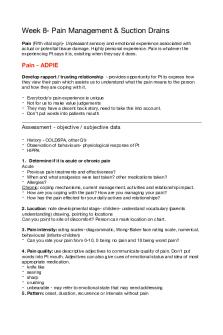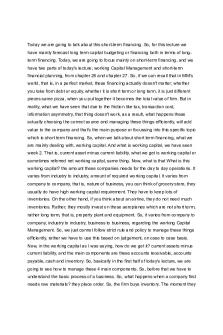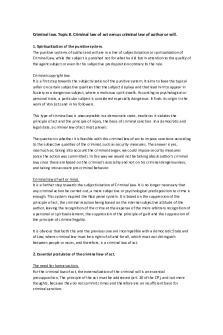FILM 114 Lecture 8 Notes PDF

| Title | FILM 114 Lecture 8 Notes |
|---|---|
| Author | Kym Forthun |
| Course | Introduction to Film |
| Institution | Minnesota State University-Mankato |
| Pages | 2 |
| File Size | 102.1 KB |
| File Type | |
| Total Downloads | 99 |
| Total Views | 154 |
Summary
Classical Narrative Structure & Narration
Vertigo film directed by Alfred Hitchcock (1958)
Professor Matt Connolly...
Description
Classical Narrative Structure & Narration Vertigo film by Alfred Hitchcock (1958) ● Basics of Narrative Structure and Narration ○ Think back to Citizen Kane ■ What are some words that you would use to describe Charles Foster Kane? ■ How did you feel about him as a character? Did those feelings change across the film? ○ Questions of: ■ Character identification ■ Revelations of narrative information ■ Suspense and surprise ■ All tie back to issues of how a film constructs its narrative ○ What is a “narrative”? ■ A chain of events linked by cause and effect and occurring in time and space ● Actions that occur in the story ● Jaws - First, a shark attacks a swimmer on the beach; Then, Brody wants to close the beaches as a result; As a result, the mayor refuses his request while talking to him in town ○ Plot vs. Story ■ Plot - all the events that are directly presented to us ● The plot is constructed by choosing and arranging story elements in a particular way ■ Story - all the events we see and hear plus all those that we infer or assume to have occurred ○ Example - North by Northwest ■ Plot: ● Rush hour in Manhattan ● Roger gets off the elevator and walks with his secretary ■ Story: ● (Roger works a busy day in his office) ● Rush hour in Manhattan ● (Roger gets on the elevator and talks to his secretary) ● Roger gets off the elevator and walks with his secretary ■ The plot that we see on the screen here is making decisions about what to include explicitly and what it assumes the audience can infer about the situation ■ All film narratives make such decisions ○ Time in Narrative - Options for Manipulation ■ Order- can present story events out of order in the plot
● Example: flashback ■ Duration - can skip over years of time in the story through their arrangement in the plot ■ Frequency - can also us to see the same story action from multiple viewpoints ○ Narration- the plot’s way of distributing story information to achieve specific ends ■ The moment-by-moment process that guides viewers to build the story out of the plot ○ Issues of Narration ■ Range of Narration ● How restricted or unrestricted is the viewer’s access to characters and information? ● Restricted - A Man Escaped ● Unrestricted - Citizen Kane ■ Depth of Narration ● How much or little access does the viewer have to a character’s subjectivity (mental and/or perceptual) ● Subjective - A Man Escaped ● Objective - Trouble in Paradise ■ Both are spectrums; very few films are COMPLETELY restricted or COMPLETELY unrestricted ○ Classical Hollywood Narrative - 5 components ■ Goal-oriented Protagonist - the main character with a clear goal or ambition that is defined early and worked towards across the film ■ Cause & Effect- the actions that occur in a scene are motivated by the previous scene and will motivate the actions in the next scene ■ Serious of Obstacles Structures the Plot ■ Deadlines and Appointments Motivate Plot Progression ■ Clear closure is achieved by film’s end ● Vertigo (Hitchcock, 1958) ○ What do you think and feel about Scottie at the beginning of the film? How does that change across the film? ○ What is the general range of narration? Does that change and, if so, how does it affect our understanding of scottie?...
Similar Free PDFs

FILM 114 Lecture 8 Notes
- 2 Pages

FILM 114 Lecture 6 Notes
- 2 Pages

FILM 114 Lecutre 11 Notes
- 4 Pages

Week 8 Art 114
- 2 Pages

8 - Lecture notes 8
- 21 Pages

8 - Lecture notes 8
- 21 Pages

Film Form - Lecture notes 1
- 2 Pages

Yoga Notes - LFIT 114
- 3 Pages

8 Midwifery - Lecture notes 8
- 3 Pages

Taxation 8 - Lecture notes 8
- 2 Pages

Week 8 - Lecture notes 8
- 6 Pages

Dox 8 - Lecture notes 8
- 21 Pages

Lesson 8 - Lecture notes 8
- 2 Pages

Assignment 8 - Lecture notes 8
- 4 Pages
Popular Institutions
- Tinajero National High School - Annex
- Politeknik Caltex Riau
- Yokohama City University
- SGT University
- University of Al-Qadisiyah
- Divine Word College of Vigan
- Techniek College Rotterdam
- Universidade de Santiago
- Universiti Teknologi MARA Cawangan Johor Kampus Pasir Gudang
- Poltekkes Kemenkes Yogyakarta
- Baguio City National High School
- Colegio san marcos
- preparatoria uno
- Centro de Bachillerato Tecnológico Industrial y de Servicios No. 107
- Dalian Maritime University
- Quang Trung Secondary School
- Colegio Tecnológico en Informática
- Corporación Regional de Educación Superior
- Grupo CEDVA
- Dar Al Uloom University
- Centro de Estudios Preuniversitarios de la Universidad Nacional de Ingeniería
- 上智大学
- Aakash International School, Nuna Majara
- San Felipe Neri Catholic School
- Kang Chiao International School - New Taipei City
- Misamis Occidental National High School
- Institución Educativa Escuela Normal Juan Ladrilleros
- Kolehiyo ng Pantukan
- Batanes State College
- Instituto Continental
- Sekolah Menengah Kejuruan Kesehatan Kaltara (Tarakan)
- Colegio de La Inmaculada Concepcion - Cebu

